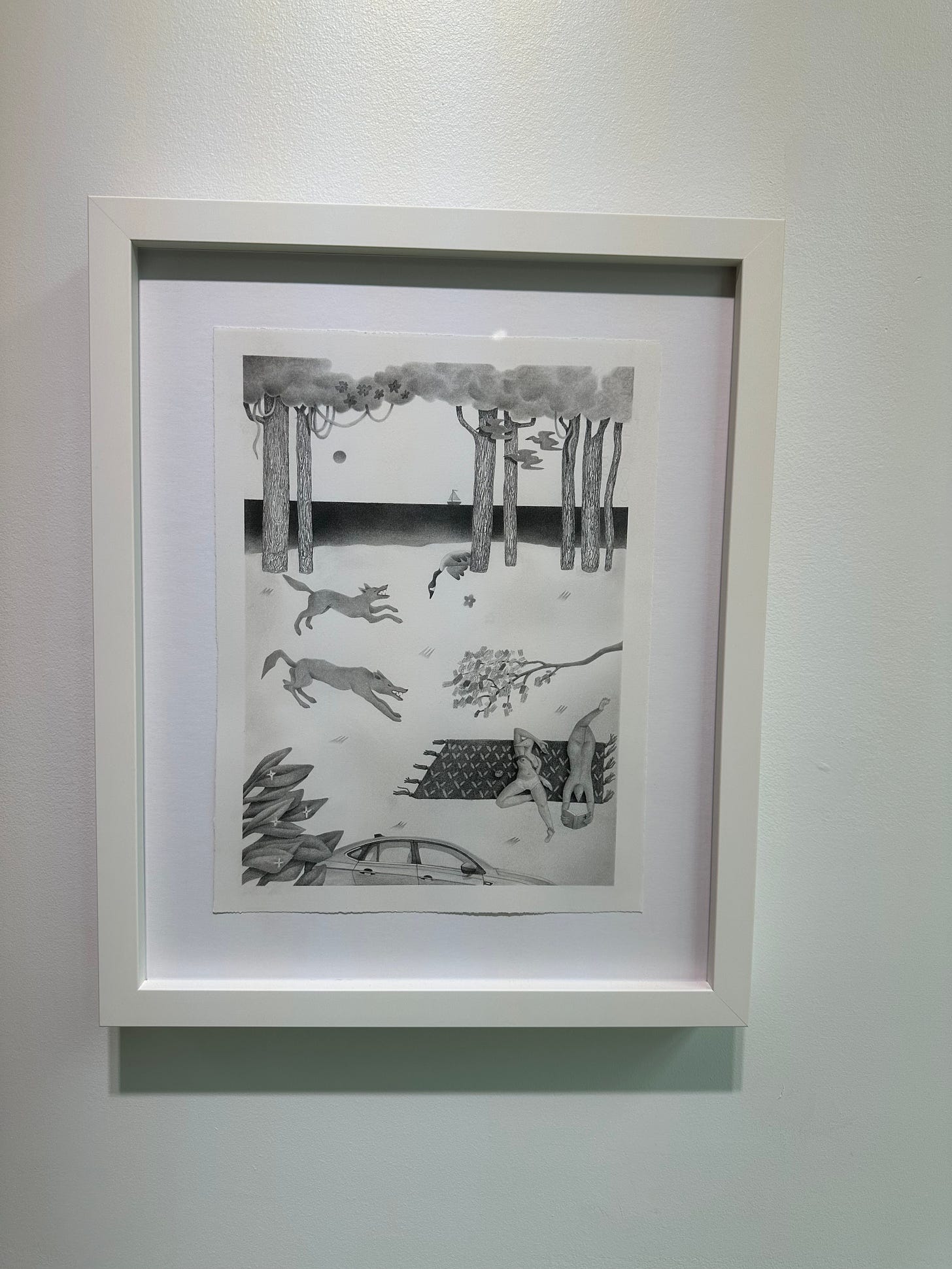Julia Signe: Birds of No Feather @ Povos Downtown
I have a real soft spot for children’s book illustrations, which Julia Signe’s exhibition, Birds of No Feather, is quick to evoke. But as it stands, I am a critic and not a jury member for the Caldecott Medal. If Birds of No Feather’s storybook posturing is what lends the work its appeal, it is also the exhibition’s Achilles heel.
Upon walking into Povos’s new Van Buren Street storefront, it is glaringly obvious that Signe is in possession of some top-notch drafting chops, but the question remains as to whether or not the work is capable of communicating anything beyond whimsy and illusion. In the few moments where idiosyncrasy is encountered, it ought to be savored. Fires take the shape of cardboard cutouts, a teary-eyed, muppet-like visage emerges from a stone, and an awkwardly cropped vehicle idles reliably near trouble.
Disappointingly, these moments of intrigue are outnumbered by instances where Signe seems too eager to catch her viewers’ attention. Occasionally, this tendency ends up stumbling into millennial-core “woah so random!” territory, begging more for eye-rolls than eye contact. Two larger-than-life hyperrealistic kittens are transposed into one drawing; a snake-like figure with big watery eyes sticks its head and tongue out from under a rock; and even the depiction of an attempted assassination feels bereft of the impish jouissance of cartoon violence.
It isn't difficult to be content with Signe’s drawings for what they are on the surface—charming vignettes of a fantasy world—but I would like to imagine that more was intended for them than being mere illustrations wanting for content. Despite the pretensions to “unknown folklore,” Birds of No Feather treads too much towards the esoteric to be allegorical, the point of the latter being that it is legible to a wide audience, hence its political and religious utility. The problem is that while the artist might know what signifiers are and the reasoning behind certain decisions, the images are burdened by an overabundance of forms and symbols that are all equally self-insistent. The resulting situation uncomfortably posits the work as being more stylistic than substantive.
The sole moment where allegory finds proper employment can be found in Greetings! From the Lake, where a lackadaisical lakeside lounge finds itself suddenly intruded upon by wolves and a dead goose. Despite intimations of impending danger, the figures appear less alarmed than they do blasé, seemingly content or perhaps even desperate to milk what pleasures of the day remain before having to perish or make an escape in the nearby sedan. Perhaps owing to the significant amount of negative space in comparison to the other drawings, Signe’s hand makes itself apparent in ways it before had not. By indulging in the basic act of mark-making rather than forming seamless illusory spaces, Signe allows her viewer a moment to ascertain why she works in graphite as opposed to any other paper-friendly media. There are no overindulgences or self-concerned distractions, and despite offering far less visual information than some of its counterparts on view, it delivers greater intellectual and formal dividends.
Similarly successful (albeit for different reasons) is California Girl, which eschews the bucolic settings found in most of the other drawings to feel like a mashup of a noir film still and a GTA loading screen. Signe’s singular anthropomorphized avian stands against a dusky sky, palm trees and searchlights dimly visible through the firmament behind. Gaze cast elsewhere, furtively toying with a set of chopsticks, the figure wears a necklace that reads “Kitten.” California Girl approaches a casual mannerism that plays down any allusion to values exterior to, or encrypted within, the image, thereby allowing the glamour and ponderous loneliness that is visually available to speak for itself.
Though the most minimal works in the show, Greetings! From the Lake and California Girl are strong impressions of how Signe views her created world and our own. Affects are embodied rather than buried, and the settings feel more immediate than idyllic. I would argue that it is this inkling of familiarity that allows both drawings to act as a smooth egress into Signe’s pictorial imaginary, where all the others struggle for want of such ease.




